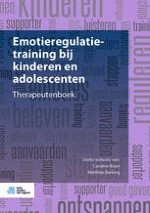
2019 | OriginalPaper | Hoofdstuk
1. Emotieregulatie bij kinderen: ontwikkeling en definities
Auteurs : Caroline Braet, Lien Goossens
Gepubliceerd in: Emotieregulatietraining bij kinderen en adolescenten
Uitgeverij: Bohn Stafleu van Loghum

2019 | OriginalPaper | Hoofdstuk
Auteurs : Caroline Braet, Lien Goossens
Gepubliceerd in: Emotieregulatietraining bij kinderen en adolescenten
Uitgeverij: Bohn Stafleu van Loghum
Print ISBN: 978-90-368-2307-4
Elektronisch ISBN: 978-90-368-2308-1
Copyright: 2019